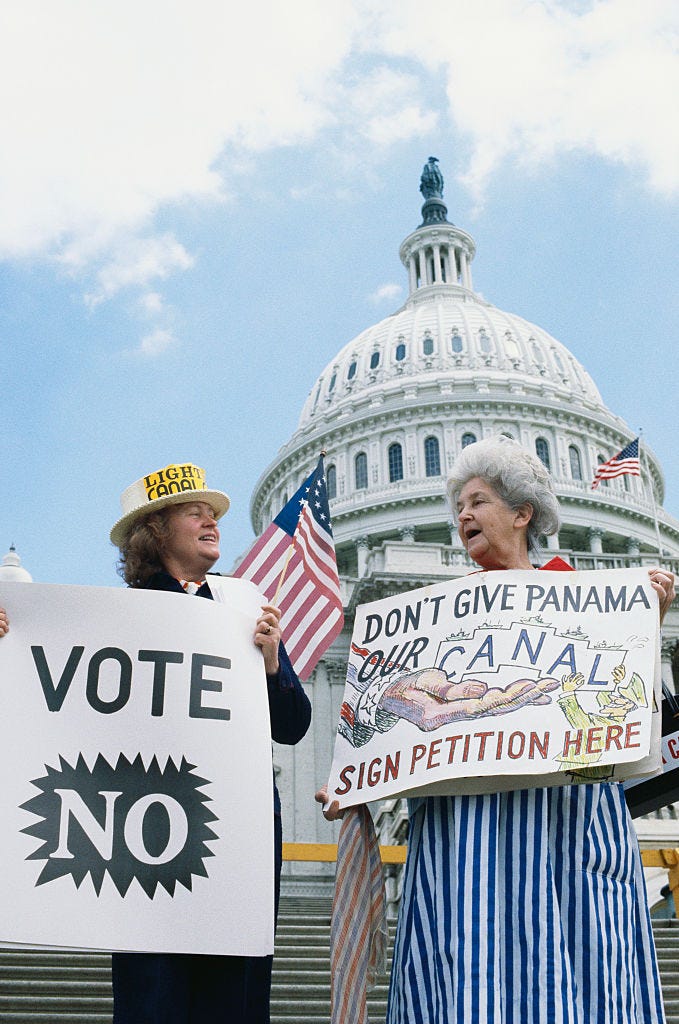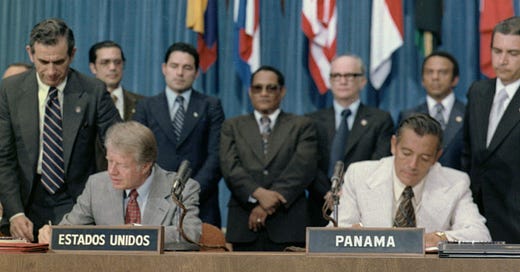
The Free Press

Even after he spoke of it in his inaugural address, foreign policy mavens still didn’t quite know if they should take President Trump’s obsession with the Panama Canal seriously. Now that his secretary of state, Marco Rubio, has just demanded “immediate changes” at the canal, no one is laughing anymore—at least no one should be.
The ostensible source of Trump’s concern is that, as he said in his address, “China is operating the Panama Canal, and we didn’t give it to China.” It’s true that a Hong Kong–based company operates ports on both the Atlantic and the Pacific ends of the waterway. This gives China a foothold that the authors of the treaty ceding the canal to Panama never contemplated. But it is not the same as “operating” the canal; the Panama Canal Authority, an autonomous agency, does that.
Whether the Hong Kong company’s position creates leverage China could use against the U.S. is nevertheless a matter of debate. What’s not debatable is Trump’s belief that it could. As he repeated after Rubio’s visit, “We’re going to take it back, or something very powerful is going to happen.”
Panama seems impressed. It has already agreed to exit China’s Belt and Road infrastructure funding initiative. Also clear is that this geopolitical fight doubles as a bold domestic political move—Trump is tapping “something very powerful” within the collective psyche of the American right.
Consciously or not, he is staging a remake of the political drama that unfolded five decades ago, in which then-outsider Ronald Reagan turned opposition to U.S. transfer of sovereignty over the Panama Canal into rocket fuel for his 1976 and 1980 presidential campaigns. And then, as now, the canal issue served as a two-edged sword with which a newly assertive right, headed by an anti-Washington outsider, could smite both weak-kneed liberals and the GOP establishment.
It’s impossible to grasp what Trump is doing now without understanding what Reagan did in the 1970s.
It’s hard to overstate the role that the Panama Canal once played in the American imagination. For generations after the U.S. completed the project in 1914, American schoolchildren learned that the canal was the “eighth wonder of the world,” an engineering marvel that other nations had tried and failed to achieve, and thus epitomized U.S. ingenuity, determination, and sacrifice. Costing $375 million (roughly $10 billion today), the canal was the most expensive construction project in American history. Nearly 6,000 people, mostly workers from Barbados but also 300 Americans, lost their lives building it. It was all worth it, kids were taught—and adults believed—because by linking the Atlantic and the Pacific oceans, it embodied America’s rightful rise to global preeminence.
Yet American pride had a counterpart in Latin American resentment over what nationalists in the region depicted as an imperial gash through an independent country. Riots outside the Canal Zone became a regular occurrence during the twentieth century. Fearing negative repercussions for the Cold War, and feeling pangs of imperial guilt, Republicans and Democrats began to believe it would be wiser to salve Latin America’s wounded feelings than to insist on America’s prerogatives.
Democratic president Lyndon Johnson opened negotiations to cede American sovereignty over the canal to Panama—while maintaining the right to defend it in case of attack. This was a strategy his Republican successors, Richard Nixon and Gerald Ford, continued. In June 1975, two months after the fall of Saigon, Secretary of State Henry Kissinger warned Ford of a “Vietnam-type situation” in Latin America if negotiations over the canal did not advance.
When Reagan announced his long shot challenge to Ford for the Republican presidential nomination in November, he didn’t mention the Panama Canal. By March 1976, however, after he had lost five primaries in a row, his campaign had gone broke, and his wife Nancy had begun to urge him to drop out, Reagan noticed that his stump speech line about the canal always seemed to trigger loud applause: “We bought it. We built it. It’s ours!”
In a country reeling from its humiliating defeat in Vietnam, Reagan’s appeal to a glorious past in Panama struck a chord. He went on to win the North Carolina primary, swept all 96 delegates in Texas, and over the course of three days, won contests in Alabama, Georgia, and Indiana.
By May of 1976, Reagan actually led the delegate count. Though he eventually lost narrowly to Ford at the GOP convention that summer, he emerged as the party’s undisputed star after Ford lost to Jimmy Carter in November. Had Reagan not tapped the anger many Americans felt over the Panama Canal “giveaway,” had he not expressed his outrage at the indignity of America being made to grovel before a country like Panama, it’s likely that his political career would have ended before the convention.
As president, Carter pursued the Panama Canal Treaties that handed both the waterway and a 10-mile–wide U.S.-controlled zone around it to Panama, albeit gradually over a period of years. Conservative GOP activists, however, learning from the 1976 Reagan campaign, made opposition to the treaties a centerpiece of the midterm elections in 1978—the year the Senate ratified them. And they did so again in 1980, when Reagan won the White House and Republicans retook the upper chamber for the first time since 1955.

“In each of the targeted campaigns. . . when we ask, ‘What is the major failing?’ the Panama Canal comes up as either number one or two,” Terry Dolan, one of the period’s most important conservative activists, told a newspaper in Idaho, where the issue helped GOP challenger Steve Symms beat liberal Democratic stalwart Frank Church. According to New York Times political reporter Adam Clymer, “at least five” of the dozen Democratic senators who lost their seats that year were defeated in part due to their support for the canal treaties.
Trump’s threat to grab the canal back eerily resembles Reagan’s opposition to “giving it away.” In both cases, media and foreign policy elites failed to comprehend the political saliency of an issue they considered fringy and obscure.
“The cognoscenti in Washington had just the opposite view,” Reagan aide Peter Hannaford recalled of his former boss’s canal crusade, “that anybody who’s against this is a troglodyte.” Those words could have been written about Trump and his supporters today.
Like the Trump movement generally, the right’s opposition to the canal treaties was a grassroots, populist, anti-establishment cause. “Our strength is not in Washington,” conservative direct-mail activist Richard Viguerie, who raised millions of dollars off the canal issue, boasted in 1977. “Our strength is in Peoria and Oshkosh and White River Falls.” One movement leader said that the canal debate was “an excellent opportunity to seize control of the Republican Party,” with every senator’s position on the treaties a litmus test for ideological purity.
The strongest parallel between Trump and Reagan’s approach to the Panama Canal, however, is that both framed the issue as a matter of national renewal in the face of decline, symbolized by loss of control over the waterway. Ever since the canal’s construction, the debate over its ownership has never been exclusively about the canal’s practical uses, but also about the nature of America’s role in the world. To both Reagan and Trump, America is too great to let pissant little countries order it around.
Also a factor in their thinking: the need to send a signal of strength to distant great powers, the Soviet Union for Reagan, and in Trump’s case, China, which he sees as having been granted special privileges by the waterway’s Panamanian operators.
The overriding theme of Trump’s 2016 candidacy was anger over America being “ripped off” by other countries. Forty years prior, lamenting the proposed concessions to a military regime led by left-leaning General Omar Torrijos, Reagan declared America “should tell Panama’s tinhorn dictator just what he can do with his demands for sovereignty over the Canal Zone.” It was a PG-13 version of the way Trump expresses his contempt for selected foreign leaders.
The pursuit of dominance over the Panama Canal is a classic example of what Walter Russell Mead terms the Jacksonian school of American foreign policy thought, an ideological blend of unapologetic nationalism, suspicion of elites, skepticism of the liberal world order, and disdain for global opinion. The reputational damage that continued American control over the canal would inflict—according to foreign policy experts—didn’t bother Reagan, nor has a much fiercer international outcry inhibited Trump from refusing to rule out military action to recover it.
Donald Trump may not know the history of how the Panama Canal issue powered the rise of the modern conservative movement. But he instinctively grasps, better than anyone, the emotions it stirs within the American psyche—and how to turn it into political energy.
Watch Reagan debate William F. Buckley Jr. on the Panama Canal Treaties here:



